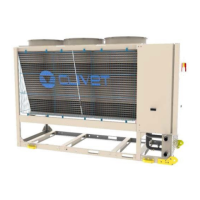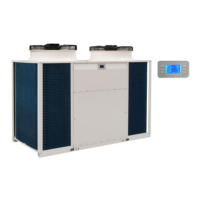Check evaporator water flow rate
Check that the difference between the temperature of exchanger
return and supply water corresponds to power according to this
formula:
unit cooling power (kW) x 860 = Dt (°C) x flow rate (L/h).
The cooling power is shown in the table of the GENERAL
TECHNICAL DATA included in this manual, referred to specific
conditions, or in the tables on cooling
PERFORMANCE in the TECHNICAL BULLETIN referred to various
conditions of use.
Check for water side exchanger pressure drops:
Determine the water flow rate.
Measure the difference in pressure between exchanger input
and output and compare it with the graph on WATER SIDE
EXCHANGER PRESSURE DROPS
The measurement of pressure will be easier if pressure gauges
are installed as indicated in the DIAGRAM OF SUGGESTED WATER
CONNECTIONS.
UNITS IN MULTIPLE CONFIGURATION
Complete system management is carried out by the master unit,
identified by address 0.
Thermoregulation takes place on the supply temperature of the
entire system (Tw).
At switch-on, when a load is requested, the units are switched on
in sequence based on their address, in numerical order.
When the load decreases, the units are switched off following the
same sequence.
Example in heating
each unit turns on if:
Tw ≥ (setpoint + Tw_diff + 1°C)
each unit turns off if:
Tw ≤ (setpoint - 1°C)
At power on, If Tw ≥ set point + 10°C
the control activates 50% of the resources in sequence based
on the set address.
after a time interval (default: 240 seconds)
if the load increases, additional resources are activated
if the load decreases, the units are switched off following the
same sequence
(first start, first stop).
If Tw < set point + 10°C
the control activates only the master unit.
after a time interval (default: 240 seconds)
if the load increases, additional resources are activated based
on the set address
if the
load decreases, the master unit switches off.

